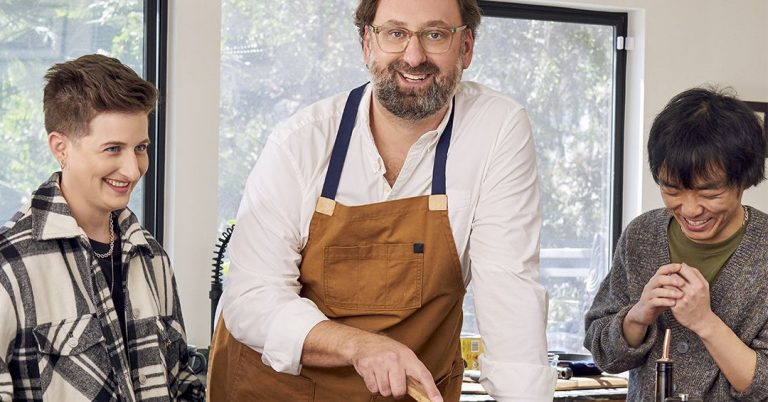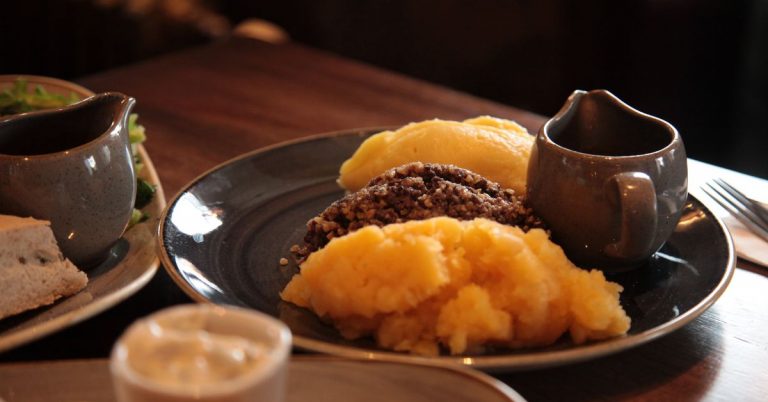Restaurant Design Right Now — and What’s Next
At Under, diners sit in a room immersed 16 feet into the frothing seas along the craggy coast of Lindesnes, Norway, eating ingredients like sea arrow grass and salty sea kale, as if to confirm that they are indeed at Europe’s first underwater restaurant. At Copenhagen, Denmark’s Alchemist, housed in the former set workshop of the Royal Danish Theatre, guests spend the duration of a 50-course tasting menu under a domed, planetarium-like ceiling on which projections of the ocean or a twinkling night sky move and change; it’s one of several design elements meant to form a holistic experience that engulfs the diner. And at Carbone’s new South Beach outpost, painted beams mimic malachite and the walls are sheathed in a custom velvet damask — cinematic touches that make the guests themselves feel like the star of a meal.
“A restaurant environment is a lot like theater — on a stage, the actors need to have a clear pathway so they don’t fall, and the audience needs to ‘read’ the cues of what to expect,” says Ellen Fisher, vice president for academic affairs and dean of the New York School of Interior Design. At a restaurant, design takes into account not just the visual set dressing but also every element that dictates how diners will interact with the space: how they might press their bodies together to fit into a booth, how the weight of a dining chair feels when they pull it from the table, how much their pupils dilate in response to dimmed lighting. These are the all-important cues that tell an audience of diners “this place is expensive,” “this place is intimate,” “this place is welcoming.”
Design firms are often the ones tasked with subtly (or not so subtly) creating those cues, and frequently, they’re pushing the proverbial envelope when it comes to what dining experiences can be. It was the Oslo, Norway-based design firm Snøhetta that managed to create the feeling of being comfortably shipwrecked at Under; Studio Duncalf crafted an upscale planetarium at Alchemist; and Ken Fulk is the designer responsible for making Miami’s Carbone feel like the place to be.
Because the first thing you register when you step into a restaurant is the way the space looks, restaurant design is often discussed in terms of the immediate: the biggest trends, the recurring atmospheres, and the vibes that both respond to and drive how diners want to interact with restaurants right now. Here are five of the design firms at the forefront of that conversation:
History Reborn with Roman and Williams
When chef Daniel Rose’s Le Coucou opened in New York in 2016, diners flooded Instagram with images of its Francophile-leaning interiors by Roman and Williams. Founded in 2002, the New York City-based firm designs restaurants as well as residences, retail, and custom pieces, such as handsome walnut dining tables and burnished-brass and glass-pendant lights made in France.
Roman and Williams is renowned across the globe for its “eccentric neo-traditional” work, says co-founder and principal Stephen Alesch, and it has won myriad awards, including the Cooper Hewitt National Design Award. “We like to flow with a continuation of historical approaches and not destroy them or wipe them away,” Alesch says. “We prefer to build on them and play with them and invent new forms with them.”
/cdn.vox-cdn.com/uploads/chorus_asset/file/22936281/01_LaMercerieInsideRomanandWilliamsGuild_RobertWright_2.jpg)
Credit: Robert Wright/La Mercerie
/cdn.vox-cdn.com/uploads/chorus_asset/file/22936282/02_LaMercerieInsideRomanandWilliamsGuild_ZephColombatto_1_Crop.jpg)
Credit: Zeph Colombatto/La Mercerie
/cdn.vox-cdn.com/uploads/chorus_asset/file/22936283/03_NoMad_London_Atrium_phto_credit_Simon_Upton_2.jpg)
Credit: Simon Upton/NoMad London
/cdn.vox-cdn.com/uploads/chorus_asset/file/22936284/04_NoMad_London_Atrium_photo_credit_Simon_Upton_1.jpg)
Credit: Simon Upton/NoMad London
/cdn.vox-cdn.com/uploads/chorus_asset/file/22936285/05_LaMercerieInsideRomanandWilliamsGuild_AndreaGentlMartinHyers_2_Crop.jpg)
Credit: Andrea Gentl and Martin Hyers/La Mercerie
At Le Coucou, this approach is evidenced by an 18th century-inspired French landscape mural, hand-painted by Dean Barger, and artful, vintage details like circa 1925 Thonet armchairs newly upholstered in olive green velvet. The NoMad London, a recent Roman and Williams project, features a glass-ceilinged, three-story atrium space; the hotel is designed to feel like “a secret garden in the [19th-century] Bow Street courthouse and police station,” says Robin Standefer, the firm’s other co-founder and principal.
“Taking a space with a heavy past and so much complexity and invading it with something beautiful, detailed, and memorable is a signature of RW,” Alesch says.
Even in a newly constructed contemporary space, a sense of story carries over. At La Mercerie, tucked inside the Roman and Williams Guild shop in New York’s Soho, thick marble slab counters and a “watery-blue” color palette summon Old World Paris. The plates were carefully selected to “break free” from the usual oversize white version used in fine dining restaurants. “[They’re] all studio pottery and handmade,” Standefer says. “People just love the experience of being able to eat off of objects that are not generic.” And it perfectly suits the Roman and Williams aesthetic: nodding to the past and embracing luxury in the present.
New Narratives with AvroKO
At Single Thread in Healdsburg, California, AvroKO’s elaborate visual tales emerge in full force. There, the owners’ love for the earth is reflected in floral arrangements under glass terrariums and even, more subtly, in the dining room screens, which are woven in patterns that summon the DNA sequences of herbs.
The New York City-based studio AvroKO, which won a James Beard Award for Outstanding Restaurant Design for Single Thread in 2017, prides itself on “narrative-based design,” according to managing director Kimberly Jackson. “We use interwoven narratives to craft layered, textured, detailed spaces that are the tangible realization of the restaurateur’s vision.”
/cdn.vox-cdn.com/uploads/chorus_asset/file/22936267/01_GALDONES_PHOTOGRAPHY_Momotaro_10OCT2014_1.jpg)
Credit: Galdones Photography/Momotaro
/cdn.vox-cdn.com/uploads/chorus_asset/file/22936268/03_thewayward_final_0126.jpg)
Credit: Andrew Thomas Lee/The Wayward
/cdn.vox-cdn.com/uploads/chorus_asset/file/22936269/05_thewayward_final_0109.jpg)
Credit: Andrew Thomas Lee/The Wayward
/cdn.vox-cdn.com/uploads/chorus_asset/file/22936270/06_GALDONES_PHOTOGRAPHY_Momotaro_10OCT2014_5.jpg)
Credit: Andrew Thomas Lee/The Wayward
This translates as much to carefully selected small details as it does to obvious choices like wallcoverings and chairs. “[At Chicago’s Momotaro] we installed a working 1960s pink pay phone that plays a random selection of Japanese audio clips from movies, commercials, music, and pink films,” Jackson says. At Nan Bei, a restaurant located on the 19th floor of the Rosewood hotel in Bangkok, AvroKO installed 800 hand-folded brass and LED magpies that dangle in the 22-foot-high atrium.
AvroKO is always aiming to whip up memorable experiences, says chief creative officer Nick Solomon. “These moments are enforced through layered narrative, clever design, and operational prowess: the booth that hugs you and keeps you for hours, palettes of materials that speak to a sense of place or culinary tradition, convenience and surprise in the unspoken details, and a sense of the unique — something which cannot be replicated.”
Fun Meets Functional with Bells + Whistles
Bells + Whistles’ co-founder and creative director Barbara Rourke knows that it’s vital to connect a restaurant’s design with the chef’s vision for the food. “What we try to do is get to know our client on a personal level and design things that feel authentic to them, like they were designing it themselves,” Rourke says. It’s an approach that’s paid off since the Los Angeles-based commercial project design firm was founded in 2000 to tackle a variety of spaces, from hospitality to multiunit residential.
Rourke likens the design process to weaving together a complete circle and says that everything — including the menu, aesthetics of the space, branding, and every touch point the guest encounters — should fall in line with a single vision, lest the space feel awkward. “You’ve gone into places and been like, ‘Oh wow, there’s no connection here between the design and what they’re trying to do as far as the food,” Rourke says.
/cdn.vox-cdn.com/uploads/chorus_asset/file/22936185/01_Dustin_Bailey_Animae_01_Main.jpg)
Credit: Dustin Bailey/Animae
/cdn.vox-cdn.com/uploads/chorus_asset/file/22936186/02_Dustin_Bailey_Animae_02.jpg)
Credit: Dustin Bailey/Animae
/cdn.vox-cdn.com/uploads/chorus_asset/file/22936187/03_Dustin_Bailey_Animae_04.jpg)
Credit: Dustin Bailey/Animae
/cdn.vox-cdn.com/uploads/chorus_asset/file/22936189/04_Dustin_Bailey_Animae_03.jpg)
Credit: Dustin Bailey/Animae
/cdn.vox-cdn.com/uploads/chorus_asset/file/22936190/05_Dustin_Bailey_Animae_05.jpg)
Credit: Dustin Bailey/Animae
/cdn.vox-cdn.com/uploads/chorus_asset/file/22936191/06_Dustin_Bailey_Animae_06.jpg)
Credit: Dustin Bailey/Animae
A singular vision is paramount at San Diego’s Animae steakhouse, which combines Art Deco lines with a palette pulled from the dense cedar forests of Japan’s Yakushima Island. It’s a look intended to “create so much theater and drama,” Rourke says. Case in point: 21-foot-long draped curtains in olive green velvet and a custom 100 percent wool carpet in mottled greens and golds that resembles “lichen in a forest.”
But for Bells + Whistles, the goal isn’t just to design a restaurant that looks good; functionality is paramount. The luxe carpet at Animae has a hidden benefit: “If someone did stain it, you wouldn’t be able to tell,” Rourke says. The use of all that fabric, generally, serves a purpose. “You can have a conversation in there without screaming — the acoustics are amazing.” And in every project it designs, the Bells + Whistles team tries to create myriad seating areas within the same space “so you can come back multiple times and have different experiences.”
At the end of the day, Bells + Whistles designs restaurants to run smoothly. When a kitchen planner — an expert hired by restaurateurs to lay out a functional workspace — recently wanted to put the door at one end of a long and skinny restaurant “a thousand steps from one end to the other,” Bells + Whistles fought to make the portal central for ease of use. Says Rourke, “If a restaurant doesn’t work, then it’s not going to succeed.”
Over-the-Top Luxe with Nina Magon Studio
Sumptuous luxury — and lots of it — is what Houston-based designer Nina Magon’s restaurateur clients are after when they hire her firm, which was founded in 2008 and designs residential estates, hotels, restaurants, and more (the company’s name changed from Contour Interior Design earlier this year). “Bigger is better — people are coming [to restaurants] for an experience… something clients are going to remember you or the restaurant by,” she says.
/cdn.vox-cdn.com/uploads/chorus_asset/file/22936209/01_1900_160508_51fifteen.jpg)
Credit: Nina Magon/51 Fifteen at Saks Fifth Avenue
/cdn.vox-cdn.com/uploads/chorus_asset/file/22936211/03_1896_160508_51fifteen.jpg)
Credit: Nina Magon/51 Fifteen at Saks Fifth Avenue
/cdn.vox-cdn.com/uploads/chorus_asset/file/22936212/04_1954_160508_51fifteen.jpg)
Credit: Nina Magon/51 Fifteen at Saks Fifth Avenue
/cdn.vox-cdn.com/uploads/chorus_asset/file/22936213/05_1909_160508_51fifteen.jpg)
Credit: Nina Magon/51 Fifteen at Saks Fifth Avenue
/cdn.vox-cdn.com/uploads/chorus_asset/file/22936214/06_1723_160508_51fifteen.jpg)
Credit: Nina Magon/51 Fifteen at Saks Fifth Avenue
Magon’s most high-profile project was the relaunch of Houston restaurant 51 Fifteen inside Saks Fifth Avenue. “When we designed 51 Fifteen, we did the largest installation of Dekton [a high-performance manmade surface similar to quartz] in the United States, hanging octagon shapes from the ceiling,” Magon says. With its towering gold champagne shelving, the black, white, and marbleized cocktail bar is now “a huge Instagram spot — everyone takes pictures there,” thanks in part to an oversize black-and-white floral wall.
The designer finds that when a space is beautifully and functionally designed, Insta-worthiness is always a side benefit. “Uniqueness is a trend now,” Magon says. “Copying is easy. Being unparalleled and distinctive is what our industry needs to stay alive and be valued,” she says. For Magon, being distinctive often translates to palpable glamour. And the designer firmly believes that “there’s still a demand for the high-end restaurants where people can dress up.”
Earthy Elegance with Montalba Architects
Montalba Architects, founded by David Montalba in 2004 and based in both Santa Monica, California, and Lausanne, Switzerland, is known for designing sceney restaurants like Nobu Malibu — which sits inside a bleached wood and stone structure abutting the Pacific Ocean — and Santa Monica’s Cassia, an industrial space with polished concrete finishes located in an Art Deco building. Its design philosophy is to create an airy feel that blends “interior and exterior spaces into a single, fluid experience that infuses natural light, air, and views throughout as much of the interior as possible,” Montalba says.
/cdn.vox-cdn.com/uploads/chorus_asset/file/22936250/01_NOBU_PA_16_401_N17_large.jpg)
Credit: Kevin Scott and Barbara Kraft/Nobu Palo Alto
/cdn.vox-cdn.com/uploads/chorus_asset/file/22936251/02_NOBU_PA.jpg)
Credit: Kevin Scott and Barbara Kraft/Nobu Palo Alto
/cdn.vox-cdn.com/uploads/chorus_asset/file/22936252/03_NOBU_PA_16_401_N15_large.jpg)
Credit: Kevin Scott and Barbara Kraft/Nobu Palo Alto
/cdn.vox-cdn.com/uploads/chorus_asset/file/22936256/05_BirdieGs17_438_N12_large.jpg)
Credit: Birdie G’s, Courtesy Montalba Architects
/cdn.vox-cdn.com/uploads/chorus_asset/file/22936257/06_BirdieGs17_438_large.jpg)
Credit: Montalba Architects/Birdie G’s
In its design, the firm considers the dining experience from start to finish — and is careful not to forget the waiting areas that are inevitably needed at buzzing locations. “The dining experience begins at the arrival, and the most considerate restaurants plan for queuing through design solutions [that] support the overall aesthetic — be it by a special sitting zone where you’re pre-hosted, an area programmed with storytelling, a beautifully apportioned bench, or just intentionally crafted sidewalk elements,” Montalba says.
Montalba is prioritizing ways to bring his design philosophy into the future. For the founder, an environmentally thoughtful approach is essential; the firm has embraced efforts to curb carbon emissions by installing gravity ventilators, using stormwater in the landscaping, and recycling heat from the kitchen to regulate the dining area’s climate. Montalba Architects is currently working on a sustainably minded restaurant in Palo Alto, California, set to open in summer 2022. The design places seating areas throughout a leafy alfresco garden (hidden behind exterior walls) and removes the boundary between indoor and outdoor dining. “All pieces of the design were planned to maximize the experience of the landscape and views of the sky while inducing the feeling of being transported away from the urban city to a spiritual place,” Montalba says.
Kathryn O’Shea-Evans writes about design, travel, and food from her home base in Colorado’s Front Range.
Click to read the next article
by Diana Budds
Click to read the next article
by Eater Staff
Click to read the next article
/cdn.vox-cdn.com/uploads/chorus_asset/file/22938991/ezgif.com_gif_maker__4_.gif)
/cdn.vox-cdn.com/uploads/chorus_asset/file/22938990/ezgif.com_gif_maker__3_.gif)
by Hillary Dixler Canavan
Click to read the next article
/cdn.vox-cdn.com/uploads/chorus_asset/file/22938962/05b_Round_Booth_01.png)
by Terrence Doyle
Click to read the next article
by Kathryn O’Shea-Evans
Click to read the next article
by Nora Taylor
Click to read the next article
by Besha Rodell
Click to read the next article






